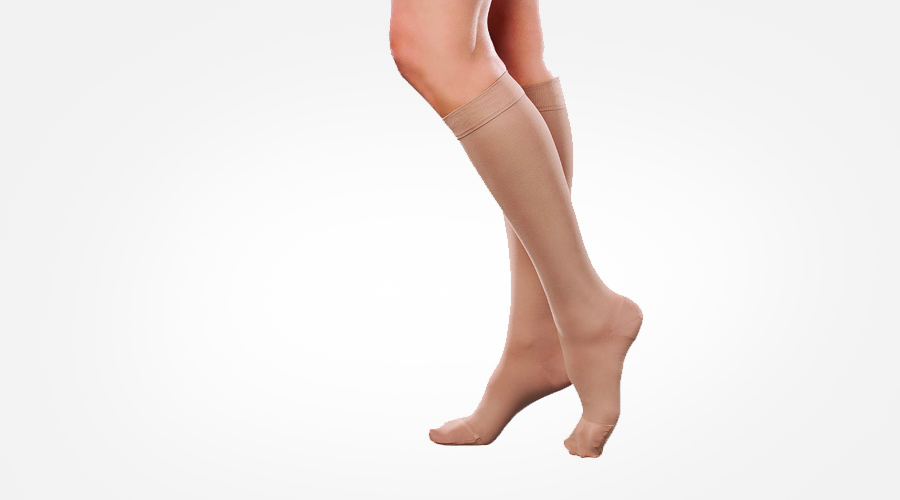When patients come into your pharmacy complaining of tired, achy legs, do you have a line of compression hose to show them?
Stocking compression hose in your front end is a smart option. Compression hose are relatively inexpensive to purchase in bulk, and they’re a complementary addition to the products you already offer.
“At some point, you’ve probably had a patient say, ‘I need support hose.’ If you don’t have the product, you’re missing out on a sale,” said Evan McGill, executive vice president of business development at Knit-Rite, Inc., the manufacturing company of Therafirm®, a brand that offers quality, gradient compression hose.
Profit support
Compression hose are typically a cash item, but that can be good for business. They may be pricier than other items in your front end, but it doesn’t take long to get a return on your investment.
McGill points to Therafirm’s Core-Spun line. “If the pharmacy carries 48 pairs, your investment in inventory is going to be under $1,000, depending on compression levels,” he said. “You’ll make about a 60 percent margin.”
If you’re hesitant, McGill recommends reassessing what you stock in your front end. For example, if you have a wall of $1 items, compression stockings might be a better option. “They’re a nice product for profit margin,” he said.
Not only is carrying a line of compression hose in your pharmacy beneficial from a moneymaking standpoint, providing a diverse profile of products will also differentiate your pharmacy and get patients in your door.
The business of compression
McGill suggests building referral sources by letting local physicians, including vascular surgeons, podiatrists and dermatologists, know you’re in the compression business. “You’d be surprised how many physicians don’t know where to send patients for compression,” he said.
“A lot of them send patients to Walmart, Walgreens or CVS, where they don’t necessarily get a nice product selection. And, they don’t get great service,” McGill said. “If the pharmacy is performing measurements and personalizedfittings,thedoctorsaregoingtorespect that and help build a referral service.”
McGill recommends remembering that, “it’s not just patients, it’s people” who need compression. It’s not only beneficial to sufferers of deep vein thrombosis (DVT), edema, and leg veins, but also to people who stand for long periods of time, pregnant women, long haul truck drivers, frequent flyers or people who experience leg pain at the end of a busy day.
McGill also recommends taking a closer look at your prescriptions to find patients who might benefit from compression. “If someone’s getting an anticoagulation medication, like a blood thinner, there’s a good chance that person has DVT. Once that DVT heals, that patient can benefit from compression,” McGill said. “We estimate that 75 percent of people who walk into the pharmacy could benefit from compression immediately.”
Stylish and modern
Some patients may be hesitant to purchase compression hose due to common misconceptions that they’re uncomfortable and hot, unaffordable, and ugly and unfashionable.
“Compression hose used to be thick, beige and unattractive,” McGill said. “Compression is now built to be more fashionable, so people want to wear it.”
Therafirm’s goal is to provide a compression version of the types of socks people wear every day. “If you’re someone who likes to wear a sheer product to work, but you need compression, we have that option,” he said.
Therafirm offers compression hose in a variety of collections, styles and compression levels. McGill recommends its Core-Spun collection for pharmacies just getting into compression. “Core-Spun is great because it comes in various compression levels, it’s unisex and its biggest feature is that it’s a very stretchy product. It’s easier to get on, and comfortable to wear,” he said. A Core-Spun display also requires as little space as 15 inches across on a counter top.
Make your pharmacy the go-to compression hose location for patients in need of support and comfort for their leg pain. “People trust their pharmacists. They trust their recommendations,” McGill said. “We really need to think of compression as medicine for your legs.”
Compression stockings vs. anti-embolism stockings
Many people don’t realize that graduated compression stockings and anti-embolism stockings have fundamental differences. Evan McGill, executive vice president of business development at Knit-Rite, Inc., the manufacturing company of Therafirm® compression hose, explains the difference.
Stocking design
Compression stockings are truly graduated compression, which means they’re tighter at the ankles and go up in a proximal direction. Anti-embolism stockings offer different pressure points.
Types of patient
Compression stockings are designed for mobile patients, while anti-embolism stockings are meant for patients who are bedridden.
Results of compression
Graduated compression hose are intended for mobile individuals who can walk and who suffer from only minor symptoms, such as ankle swelling, varicose or spider veins or edema. Anti-embolism stockings are intended to prevent blood coagulation, thrombosis and blood clotting in patients who are bedridden.












